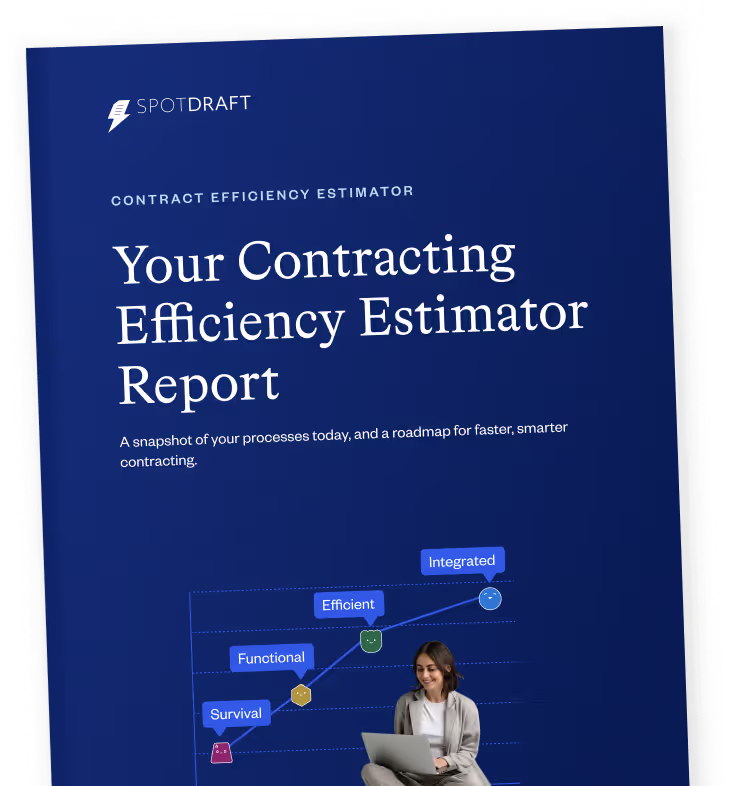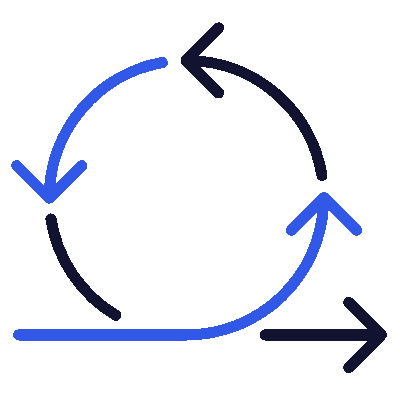49%
of legal teams still manage contracts with email. What about you?"
12%
of legal teams have achieved high automation. How do you compare?
60%
of legal teams are positioned as
business enablers. What about yours?
introduction
Why does contracting efficiency matter ?
Every business outcome starts with a contract. Revenue, partnerships, vendor relationships, and compliance—all depend on how efficiently your organization manages its contracting processes. Most legal teams, however, still operate with disconnected tools, manual workflows, and zero visibility into contract performance.
KEY FINDINGS
Here's what we discovered
We spoke to legal leaders across the U.S to understand their contracting processes.

Chapter 1
What’s the state of contracting right now?
To understand how modern in-house legal teams manage contracting, we assessed and benchmarked their contracting process across three parameters:

VOLUME

SPEED

AUTOMATION
How many contracts does your team process monthly?
3 out of 4
legal teams process 50+ contracts monthly without proper systems.
How complex are the contracts within your organization?
~90%
rate their contracts as moderate to highly complex
“Our old tool worked for simple contracts, but SpotDraft has been a game-changer for more complex workflows.”

Kerry Sheehan
Director of Legal Operations & Compliance at Doral Renewables
Why do some teams fly while others crawl?
We came across a massive performance disparity between high-performing and struggling legal teams. Organizations at the extremes show a massive difference in contract processing speed.
How long do standard contracts, such as NDAs and MSAs, typically take to complete?
1 in 3
legal teams take over 15+ days to complete standard contracts
How do you primarily manage contracts today?
49%
of Legal Teams Still Manage Contracts Like It's 1995—With Email and Word Docs

Chapter 2
Is automation the cure-all legal teams need?
Our survey captured how automation is impacting contracting processes for legal teams across industries. What we found is something we like to call ‘The Automation Paradox’.
Here’s why :
Here’s why :
How willing is your organization to automate contracting?
Ed-tech, media, and entertainment companies are the least willing to automate contracting

Chapter 3
What do high performing legal teams do differently?
The dramatic performance variations revealed in our survey data—from organizations completing contracts in 1 day to others taking 15+ days—provide valuable insights into what separates efficiency leaders from struggling teams.
Automation Level x Turnaround time
19 days
15 days
11 days
8 days
3 days
Average Efficiency
(Volume x Automation / Turnaround)
Automation increases efficiency by 73%—Each contract workflow delivers more with technology
How did we calculate average contracting efficiency score?
To measure true operational efficiency—not just speed or volume alone—we created a clear, actionable metric that compiles the three most critical levers in contracting.
Why this matters
This metric rewards both scale (handling more contracts) and maturity (higher automation), but crucially penalizes slow processes—so teams only score high if they automate and move fast. A higher score means your operation not only handles more business but closes deals quicker—showcasing real-world throughput, not just theoretical capability.

Chapter 4
Understanding future readiness and the evolution of legal teams
We analyze how contract volume growth, automation maturity, and turnaround times combine to reveal not just rising contract demands, but how efficiency and speed empower organizations to scale effectively.
Approximately how much has your contract volume increased year-over-year?
Higher automation maturity clearly correlates with faster contract growth across industries.
Why this matters
How do you envision your legal team's role evolving over the next 12 months?*
42%
Continuing current reactive support model
40%
Scaling legal support through automation
33%
Using AI tools for more strategic and less administrative tasks
14%
Shifting from ‘bottleneck’ to business enabler through streamlined contracting
*Participants in this survey could choose more than one response
This distribution illustrates a legal ecosystem evolving rapidly in response to rising contract volumes, complexity, and the availability of advanced tech solutions. The emphasis on automation and AI signals
a profound shift in skill sets, priorities, and operating models—from reactive risk mitigators to proactive partners driving business acceleration.
Demographics
To analyze this , we spoke to more than 100 legal leaders across the U.S to understand their contracting processes.
36
General Counsel
28
In-house Attorney
14
Contract Manager
10
Chief Legal Officer
4
Legal Operations Manager
5
Head of Legal and Compliance
With nearly half of respondents being senior legal executives who control budgets and strategy, the findings reflect real strategic intent—not wishful thinking. These leaders have both the power and responsibility to drive transformation.
CONCLUSION
What does the future of contracting look like?
Legal teams are at a critical turning point. The data shows that moving beyond reactive roles and embracing automation, AI, and streamlined processes is key to handling growing workloads efficiently.
By evolving into proactive business enablers, legal functions can accelerate contract cycles, reduce bottlenecks, and align more closely with business goals. Investing in this transformation will drive agility and competitive advantage in today’s fast-paced market.
By evolving into proactive business enablers, legal functions can accelerate contract cycles, reduce bottlenecks, and align more closely with business goals. Investing in this transformation will drive agility and competitive advantage in today’s fast-paced market.

.svg)
.avif)

















.avif)
